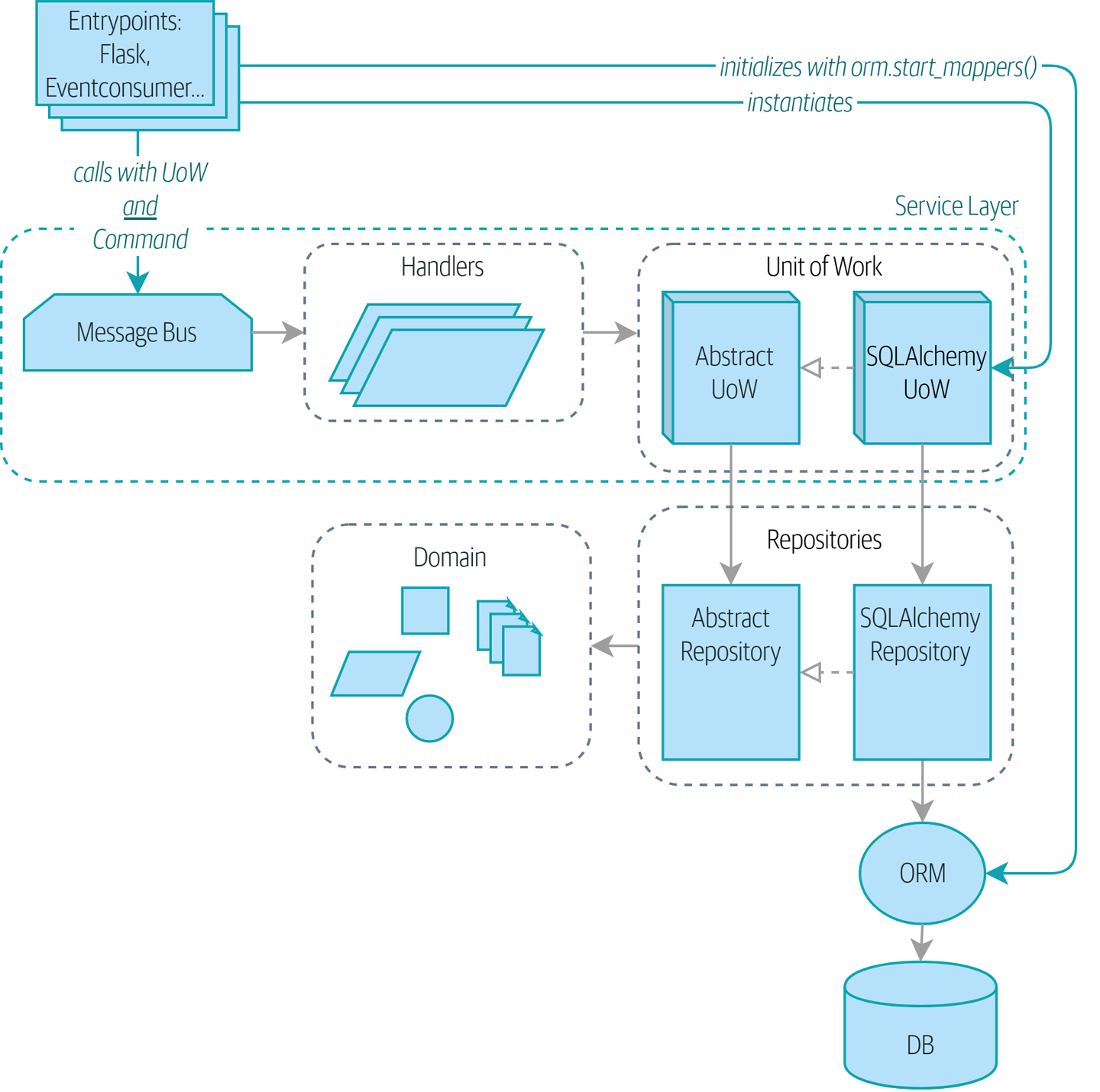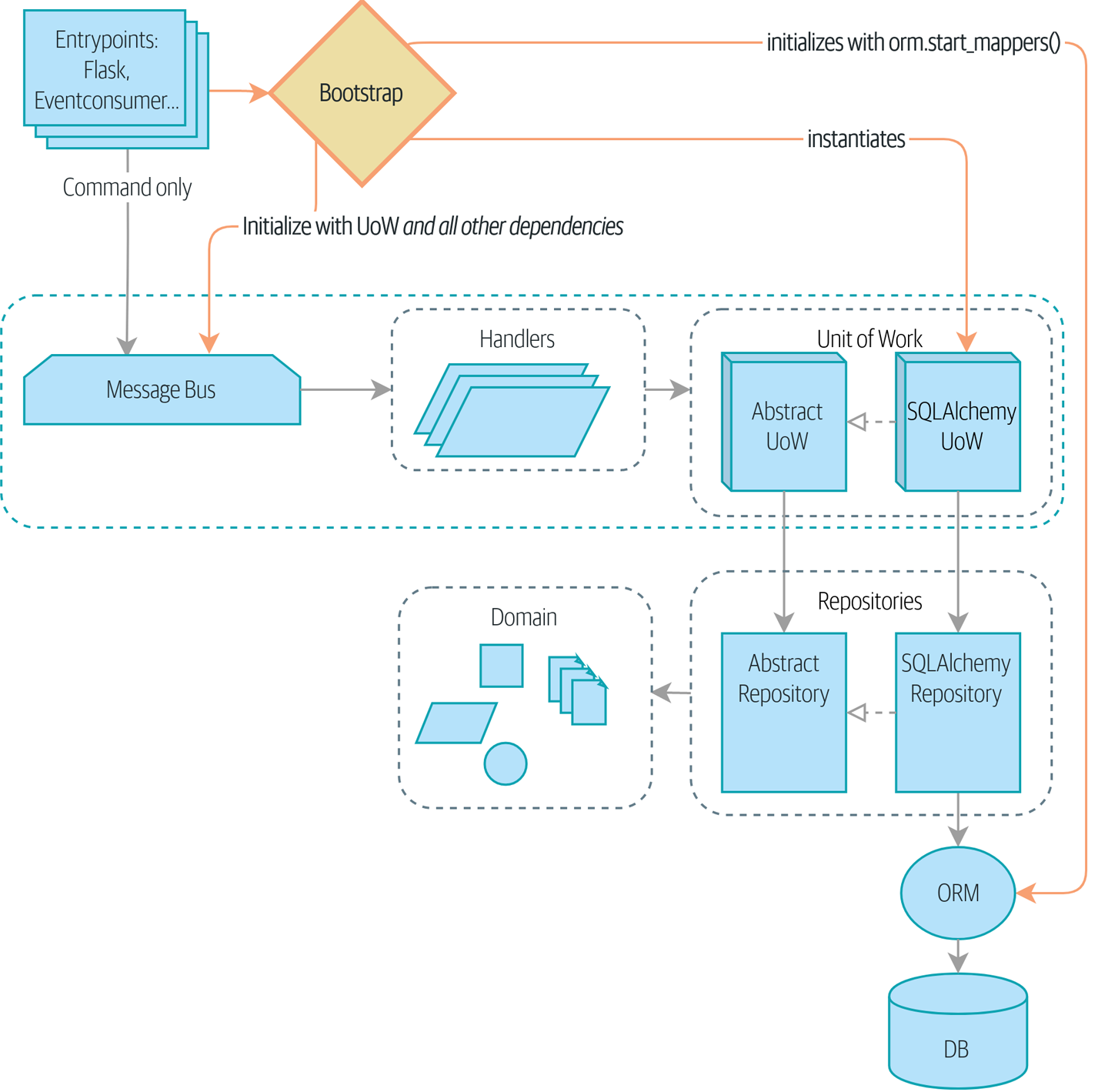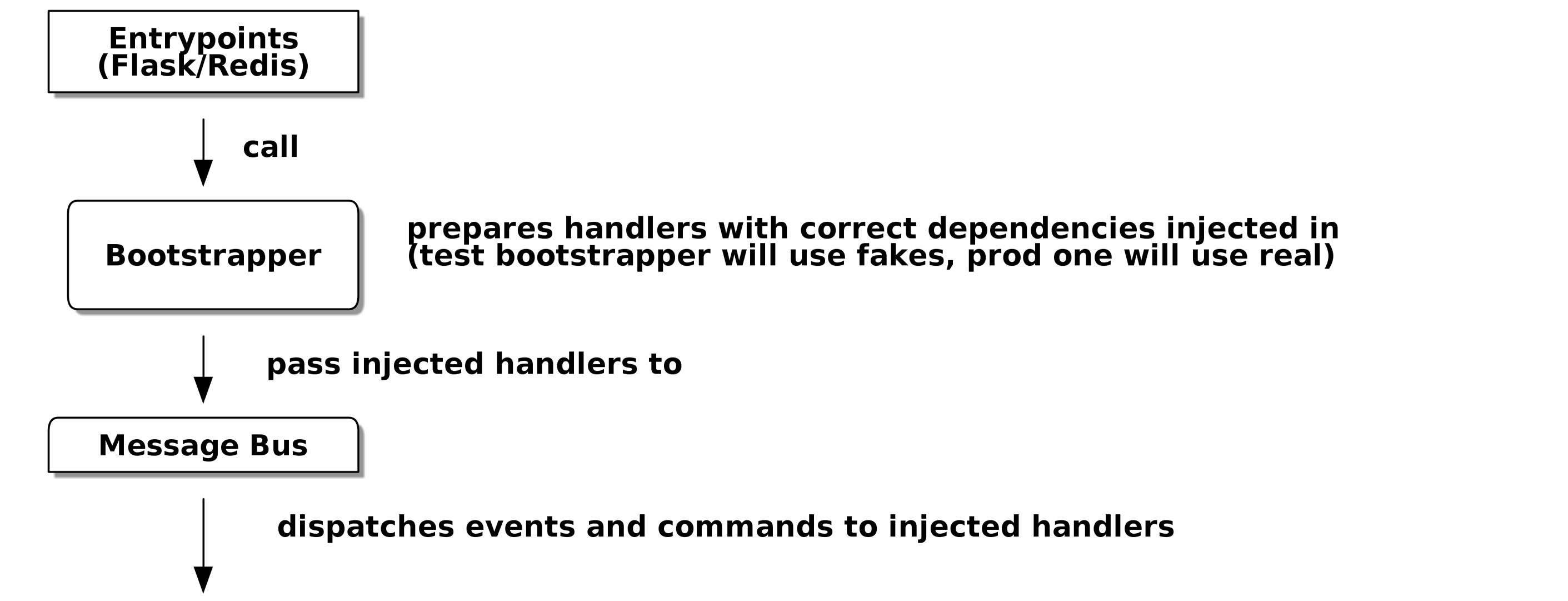13: Dependency Injection (and Bootstrapping)
Dependency injection (DI) is regarded with suspicion in the Python world. And we’ve managed just fine without it so far in the example code for this book!
In this chapter, we’ll explore some of the pain points in our code that lead us to consider using DI, and we’ll present some options for how to do it, leaving it to you to pick which you think is most Pythonic.
We’ll also add a new component to our architecture called bootstrap.py; it will be in charge of dependency injection, as well as some other initialization stuff that we often need. We’ll explain why this sort of thing is called a composition root in OO languages, and why bootstrap script is just fine for our purposes.
Without bootstrap: entrypoints do a lot shows what our app looks like without a bootstrapper: the entrypoints do a lot of initialization and passing around of our main dependency, the UoW.
|
Tip
|
If you haven’t already, it’s worth reading [chapter_03_abstractions] before continuing with this chapter, particularly the discussion of functional versus object-oriented dependency management. |

|
Tip
|
The code for this chapter is in the chapter_13_dependency_injection branch on GitHub: git clone https://github.com/cosmicpython/code.git cd code git checkout chapter_13_dependency_injection # or to code along, checkout the previous chapter: git checkout chapter_12_cqrs |
Bootstrap takes care of all that in one place shows our bootstrapper taking over those responsibilities.

Implicit Versus Explicit Dependencies
Depending on your particular brain type, you may have a slight feeling of unease at the back of your mind at this point. Let’s bring it out into the open. We’ve shown you two ways of managing dependencies and testing them.
For our database dependency, we’ve built a careful framework of explicit dependencies and easy options for overriding them in tests. Our main handler functions declare an explicit dependency on the UoW:
def allocate(
cmd: commands.Allocate,
uow: unit_of_work.AbstractUnitOfWork,
):And that makes it easy to swap in a fake UoW in our service-layer tests:
uow = FakeUnitOfWork()
messagebus.handle([...], uow)The UoW itself declares an explicit dependency on the session factory:
class SqlAlchemyUnitOfWork(AbstractUnitOfWork):
def __init__(self, session_factory=DEFAULT_SESSION_FACTORY):
self.session_factory = session_factory
...We take advantage of it in our integration tests to be able to sometimes use SQLite instead of Postgres:
def test_rolls_back_uncommitted_work_by_default(sqlite_session_factory):
uow = unit_of_work.SqlAlchemyUnitOfWork(sqlite_session_factory) #(1)-
Integration tests swap out the default Postgres
session_factoryfor a SQLite one.
Aren’t Explicit Dependencies Totally Weird and Java-y?
If you’re used to the way things normally happen in Python, you’ll be thinking all this is a bit weird. The standard way to do things is to declare our dependency implicitly by simply importing it, and then if we ever need to change it for tests, we can monkeypatch, as is Right and True in dynamic languages:
from allocation.adapters import email, redis_eventpublisher #(1)
...
def send_out_of_stock_notification(
event: events.OutOfStock,
uow: unit_of_work.AbstractUnitOfWork,
):
email.send( #(2)
"stock@made.com",
f"Out of stock for {event.sku}",
)-
Hardcoded import
-
Calls specific email sender directly
Why pollute our application code with unnecessary arguments just for the
sake of our tests? mock.patch makes monkeypatching nice and easy:
with mock.patch("allocation.adapters.email.send") as mock_send_mail:
...The trouble is that we’ve made it look easy because our toy example doesn’t
send real email (email.send_mail just does a print), but in real life,
you’d end up having to call mock.patch for every single test that might
cause an out-of-stock notification. If you’ve worked on codebases with lots of
mocks used to prevent unwanted side effects, you’ll know how annoying that
mocky boilerplate gets.
And you’ll know that mocks tightly couple us to the implementation. By
choosing to monkeypatch email.send_mail, we are tied to doing import email,
and if we ever want to do from email import send_mail, a trivial refactor,
we’d have to change all our mocks.
So it’s a trade-off. Yes, declaring explicit dependencies is unnecessary, strictly speaking, and using them would make our application code marginally more complex. But in return, we’d get tests that are easier to write and manage.
On top of that, declaring an explicit dependency is an example of the dependency inversion principle—rather than having an (implicit) dependency on a specific detail, we have an (explicit) dependency on an abstraction:
Explicit is better than implicit.
def send_out_of_stock_notification(
event: events.OutOfStock,
send_mail: Callable,
):
send_mail(
"stock@made.com",
f"Out of stock for {event.sku}",
)But if we do change to declaring all these dependencies explicitly, who will
inject them, and how? So far, we’ve really been dealing with only passing the
UoW around: our tests use FakeUnitOfWork, while Flask and Redis eventconsumer
entrypoints use the real UoW, and the message bus passes them onto our command
handlers. If we add real and fake email classes, who will create them and
pass them on?
It needs to happen as early as possible in the process lifecycle, so the most obvious place is in our entrypoints. That would mean extra (duplicated) cruft in Flask and Redis, and in our tests. And we’d also have to add the responsibility for passing dependencies around to the message bus, which already has a job to do; it feels like a violation of the SRP.
Instead, we’ll reach for a pattern called Composition Root (a bootstrap script to you and me),[1] and we’ll do a bit of "manual DI" (dependency injection without a framework). See Bootstrapper between entrypoints and message bus.[2]

[ditaa, apwp_1303]
+---------------+
| Entrypoints |
| (Flask/Redis) |
+---------------+
|
| call
V
/--------------\
| | prepares handlers with correct dependencies injected in
| Bootstrapper | (test bootstrapper will use fakes, prod one will use real)
| |
\--------------/
|
| pass injected handlers to
V
/---------------\
| Message Bus |
+---------------+
|
| dispatches events and commands to injected handlers
|
V
Preparing Handlers: Manual DI with Closures and Partials
One way to turn a function with dependencies into one that’s ready to be called later with those dependencies already injected is to use closures or partial functions to compose the function with its dependencies:
# existing allocate function, with abstract uow dependency
def allocate(
cmd: commands.Allocate,
uow: unit_of_work.AbstractUnitOfWork,
):
line = OrderLine(cmd.orderid, cmd.sku, cmd.qty)
with uow:
...
# bootstrap script prepares actual UoW
def bootstrap(..):
uow = unit_of_work.SqlAlchemyUnitOfWork()
# prepare a version of the allocate fn with UoW dependency captured in a closure
allocate_composed = lambda cmd: allocate(cmd, uow)
# or, equivalently (this gets you a nicer stack trace)
def allocate_composed(cmd):
return allocate(cmd, uow)
# alternatively with a partial
import functools
allocate_composed = functools.partial(allocate, uow=uow) #(1)
# later at runtime, we can call the partial function, and it will have
# the UoW already bound
allocate_composed(cmd)-
The difference between closures (lambdas or named functions) and
functools.partialis that the former use late binding of variables, which can be a source of confusion if any of the dependencies are mutable.
Here’s the same pattern again for the send_out_of_stock_notification() handler,
which has different dependencies:
def send_out_of_stock_notification(
event: events.OutOfStock,
send_mail: Callable,
):
send_mail(
"stock@made.com",
...
# prepare a version of the send_out_of_stock_notification with dependencies
sosn_composed = lambda event: send_out_of_stock_notification(event, email.send_mail)
...
# later, at runtime:
sosn_composed(event) # will have email.send_mail already injected inAn Alternative Using Classes
Closures and partial functions will feel familiar to people who’ve done a bit of functional programming. Here’s an alternative using classes, which may appeal to others. It requires rewriting all our handler functions as classes, though:
# we replace the old `def allocate(cmd, uow)` with:
class AllocateHandler:
def __init__(self, uow: unit_of_work.AbstractUnitOfWork): #(2)
self.uow = uow
def __call__(self, cmd: commands.Allocate): #(1)
line = OrderLine(cmd.orderid, cmd.sku, cmd.qty)
with self.uow:
# rest of handler method as before
...
# bootstrap script prepares actual UoW
uow = unit_of_work.SqlAlchemyUnitOfWork()
# then prepares a version of the allocate fn with dependencies already injected
allocate = AllocateHandler(uow)
...
# later at runtime, we can call the handler instance, and it will have
# the UoW already injected
allocate(cmd)-
The class is designed to produce a callable function, so it has a __call__ method.
-
But we use the
initto declare the dependencies it requires. This sort of thing will feel familiar if you’ve ever made class-based descriptors, or a class-based context manager that takes arguments.
Use whichever you and your team feel more comfortable with.
A Bootstrap Script
We want our bootstrap script to do the following:
-
Declare default dependencies but allow us to override them
-
Do the "init" stuff that we need to get our app started
-
Inject all the dependencies into our handlers
-
Give us back the core object for our app, the message bus
Here’s a first cut:
def bootstrap(
start_orm: bool = True, #(1)
uow: unit_of_work.AbstractUnitOfWork = unit_of_work.SqlAlchemyUnitOfWork(), #(2)
send_mail: Callable = email.send,
publish: Callable = redis_eventpublisher.publish,
) -> messagebus.MessageBus:
if start_orm:
orm.start_mappers() #(1)
dependencies = {"uow": uow, "send_mail": send_mail, "publish": publish}
injected_event_handlers = { #(3)
event_type: [
inject_dependencies(handler, dependencies)
for handler in event_handlers
]
for event_type, event_handlers in handlers.EVENT_HANDLERS.items()
}
injected_command_handlers = { #(3)
command_type: inject_dependencies(handler, dependencies)
for command_type, handler in handlers.COMMAND_HANDLERS.items()
}
return messagebus.MessageBus( #(4)
uow=uow,
event_handlers=injected_event_handlers,
command_handlers=injected_command_handlers,
)-
orm.start_mappers()is our example of initialization work that needs to be done once at the beginning of an app. Another common example is setting up theloggingmodule. -
We can use the argument defaults to define what the normal/production defaults are. It’s nice to have them in a single place, but sometimes dependencies have some side effects at construction time, in which case you might prefer to default them to
Noneinstead. -
We build up our injected versions of the handler mappings by using a function called
inject_dependencies(), which we’ll show next. -
We return a configured message bus ready for use.
Here’s how we inject dependencies into a handler function by inspecting it:
def inject_dependencies(handler, dependencies):
params = inspect.signature(handler).parameters #(1)
deps = {
name: dependency
for name, dependency in dependencies.items() #(2)
if name in params
}
return lambda message: handler(message, **deps) #(3)-
We inspect our command/event handler’s arguments.
-
We match them by name to our dependencies.
-
We inject them as kwargs to produce a partial.
Message Bus Is Given Handlers at Runtime
Our message bus will no longer be static; it needs to have the already-injected handlers given to it. So we turn it from being a module into a configurable class:
class MessageBus: #(1)
def __init__(
self,
uow: unit_of_work.AbstractUnitOfWork,
event_handlers: Dict[Type[events.Event], List[Callable]], #(2)
command_handlers: Dict[Type[commands.Command], Callable], #(2)
):
self.uow = uow
self.event_handlers = event_handlers
self.command_handlers = command_handlers
def handle(self, message: Message): #(3)
self.queue = [message] #(4)
while self.queue:
message = self.queue.pop(0)
if isinstance(message, events.Event):
self.handle_event(message)
elif isinstance(message, commands.Command):
self.handle_command(message)
else:
raise Exception(f"{message} was not an Event or Command")-
The message bus becomes a class…
-
…which is given its already-dependency-injected handlers.
-
The main
handle()function is substantially the same, with just a few attributes and methods moved ontoself. -
Using
self.queuelike this is not thread-safe, which might be a problem if you’re using threads, because the bus instance is global in the Flask app context as we’ve written it. Just something to watch out for.
What else changes in the bus?
def handle_event(self, event: events.Event):
for handler in self.event_handlers[type(event)]: #(1)
try:
logger.debug("handling event %s with handler %s", event, handler)
handler(event) #(2)
self.queue.extend(self.uow.collect_new_events())
except Exception:
logger.exception("Exception handling event %s", event)
continue
def handle_command(self, command: commands.Command):
logger.debug("handling command %s", command)
try:
handler = self.command_handlers[type(command)] #(1)
handler(command) #(2)
self.queue.extend(self.uow.collect_new_events())
except Exception:
logger.exception("Exception handling command %s", command)
raise-
handle_eventandhandle_commandare substantially the same, but instead of indexing into a staticEVENT_HANDLERSorCOMMAND_HANDLERSdict, they use the versions onself. -
Instead of passing a UoW into the handler, we expect the handlers to already have all their dependencies, so all they need is a single argument, the specific event or command.
Using Bootstrap in Our Entrypoints
In our application’s entrypoints, we now just call bootstrap.bootstrap()
and get a message bus that’s ready to go, rather than configuring a UoW and the
rest of it:
-from allocation import views
+from allocation import bootstrap, views
app = Flask(__name__)
-orm.start_mappers() #(1)
+bus = bootstrap.bootstrap()
@app.route("/add_batch", methods=["POST"])
@@ -19,8 +16,7 @@ def add_batch():
cmd = commands.CreateBatch(
request.json["ref"], request.json["sku"], request.json["qty"], eta
)
- uow = unit_of_work.SqlAlchemyUnitOfWork() #(2)
- messagebus.handle(cmd, uow)
+ bus.handle(cmd) #(3)
return "OK", 201-
We no longer need to call
start_orm(); the bootstrap script’s initialization stages will do that. -
We no longer need to explicitly build a particular type of UoW; the bootstrap script defaults take care of it.
-
And our message bus is now a specific instance rather than the global module.[3]
Initializing DI in Our Tests
In tests, we can use bootstrap.bootstrap() with overridden defaults to get a
custom message bus. Here’s an example in an integration test:
@pytest.fixture
def sqlite_bus(sqlite_session_factory):
bus = bootstrap.bootstrap(
start_orm=True, #(1)
uow=unit_of_work.SqlAlchemyUnitOfWork(sqlite_session_factory), #(2)
send_mail=lambda *args: None, #(3)
publish=lambda *args: None, #(3)
)
yield bus
clear_mappers()
def test_allocations_view(sqlite_bus):
sqlite_bus.handle(commands.CreateBatch("sku1batch", "sku1", 50, None))
sqlite_bus.handle(commands.CreateBatch("sku2batch", "sku2", 50, today))
...
assert views.allocations("order1", sqlite_bus.uow) == [
{"sku": "sku1", "batchref": "sku1batch"},
{"sku": "sku2", "batchref": "sku2batch"},
]-
We do still want to start the ORM…
-
…because we’re going to use a real UoW, albeit with an in-memory database.
-
But we don’t need to send email or publish, so we make those noops.
In our unit tests, in contrast, we can reuse our FakeUnitOfWork:
def bootstrap_test_app():
return bootstrap.bootstrap(
start_orm=False, #(1)
uow=FakeUnitOfWork(), #(2)
send_mail=lambda *args: None, #(3)
publish=lambda *args: None, #(3)
)-
No need to start the ORM…
-
…because the fake UoW doesn’t use one.
-
We want to fake out our email and Redis adapters too.
So that gets rid of a little duplication, and we’ve moved a bunch of setup and sensible defaults into a single place.
Building an Adapter "Properly": A Worked Example
To really get a feel for how it all works, let’s work through an example of how you might "properly" build an adapter and do dependency injection for it.
At the moment, we have two types of dependencies:
uow: unit_of_work.AbstractUnitOfWork, #(1)
send_mail: Callable, #(2)
publish: Callable, #(2)-
The UoW has an abstract base class. This is the heavyweight option for declaring and managing your external dependency. We’d use this for the case when the dependency is relatively complex.
-
Our email sender and pub/sub publisher are defined as functions. This works just fine for simple dependencies.
Here are some of the things we find ourselves injecting at work:
-
An S3 filesystem client
-
A key/value store client
-
A
requestssession object
Most of these will have more-complex APIs that you can’t capture as a single function: read and write, GET and POST, and so on.
Even though it’s simple, let’s use send_mail as an example to talk
through how you might define a more complex dependency.
Define the Abstract and Concrete Implementations
We’ll imagine a more generic notifications API. Could be email, could be SMS, could be Slack posts one day.
class AbstractNotifications(abc.ABC):
@abc.abstractmethod
def send(self, destination, message):
raise NotImplementedError
...
class EmailNotifications(AbstractNotifications):
def __init__(self, smtp_host=DEFAULT_HOST, port=DEFAULT_PORT):
self.server = smtplib.SMTP(smtp_host, port=port)
self.server.noop()
def send(self, destination, message):
msg = f"Subject: allocation service notification\n{message}"
self.server.sendmail(
from_addr="allocations@example.com",
to_addrs=[destination],
msg=msg,
)We change the dependency in the bootstrap script:
def bootstrap(
start_orm: bool = True,
uow: unit_of_work.AbstractUnitOfWork = unit_of_work.SqlAlchemyUnitOfWork(),
- send_mail: Callable = email.send,
+ notifications: AbstractNotifications = EmailNotifications(),
publish: Callable = redis_eventpublisher.publish,
) -> messagebus.MessageBus:Make a Fake Version for Your Tests
We work through and define a fake version for unit testing:
class FakeNotifications(notifications.AbstractNotifications):
def __init__(self):
self.sent = defaultdict(list) # type: Dict[str, List[str]]
def send(self, destination, message):
self.sent[destination].append(message)
...And we use it in our tests:
def test_sends_email_on_out_of_stock_error(self):
fake_notifs = FakeNotifications()
bus = bootstrap.bootstrap(
start_orm=False,
uow=FakeUnitOfWork(),
notifications=fake_notifs,
publish=lambda *args: None,
)
bus.handle(commands.CreateBatch("b1", "POPULAR-CURTAINS", 9, None))
bus.handle(commands.Allocate("o1", "POPULAR-CURTAINS", 10))
assert fake_notifs.sent["stock@made.com"] == [
f"Out of stock for POPULAR-CURTAINS",
]Figure Out How to Integration Test the Real Thing
Now we test the real thing, usually with an end-to-end or integration test. We’ve used MailHog as a real-ish email server for our Docker dev environment:
version: "3"
services:
redis_pubsub:
build:
context: .
dockerfile: Dockerfile
image: allocation-image
...
api:
image: allocation-image
...
postgres:
image: postgres:9.6
...
redis:
image: redis:alpine
...
mailhog:
image: mailhog/mailhog
ports:
- "11025:1025"
- "18025:8025"
In our integration tests, we use the real EmailNotifications class,
talking to the MailHog server in the Docker cluster:
@pytest.fixture
def bus(sqlite_session_factory):
bus = bootstrap.bootstrap(
start_orm=True,
uow=unit_of_work.SqlAlchemyUnitOfWork(sqlite_session_factory),
notifications=notifications.EmailNotifications(), #(1)
publish=lambda *args: None,
)
yield bus
clear_mappers()
def get_email_from_mailhog(sku): #(2)
host, port = map(config.get_email_host_and_port().get, ["host", "http_port"])
all_emails = requests.get(f"http://{host}:{port}/api/v2/messages").json()
return next(m for m in all_emails["items"] if sku in str(m))
def test_out_of_stock_email(bus):
sku = random_sku()
bus.handle(commands.CreateBatch("batch1", sku, 9, None)) #(3)
bus.handle(commands.Allocate("order1", sku, 10))
email = get_email_from_mailhog(sku)
assert email["Raw"]["From"] == "allocations@example.com" #(4)
assert email["Raw"]["To"] == ["stock@made.com"]
assert f"Out of stock for {sku}" in email["Raw"]["Data"]-
We use our bootstrapper to build a message bus that talks to the real notifications class.
-
We figure out how to fetch emails from our "real" email server.
-
We use the bus to do our test setup.
-
Against all the odds, this actually worked, pretty much at the first go!
And that’s it really.
Wrap-Up
-
Once you have more than one adapter, you’ll start to feel a lot of pain from passing dependencies around manually, unless you do some kind of dependency injection.
-
Setting up dependency injection is just one of many typical setup/initialization activities that you need to do just once when starting your app. Putting this all together into a bootstrap script is often a good idea.
-
The bootstrap script is also good as a place to provide sensible default configuration for your adapters, and as a single place to override those adapters with fakes for your tests.
-
A dependency injection framework can be useful if you find yourself needing to do DI at multiple levels—if you have chained dependencies of components that all need DI, for example.
-
This chapter also presented a worked example of changing an implicit/simple dependency into a "proper" adapter, factoring out an ABC, defining its real and fake implementations, and thinking through integration testing.
These were the last patterns we wanted to cover, which brings us to the end of [part2]. In the epilogue, we’ll try to give you some pointers for applying these techniques in the Real WorldTM.
